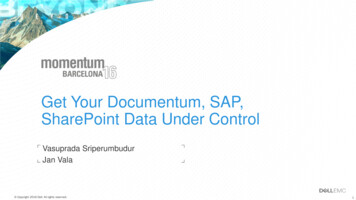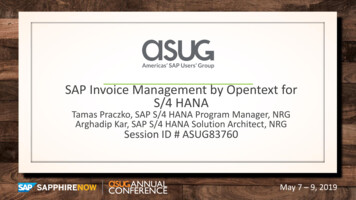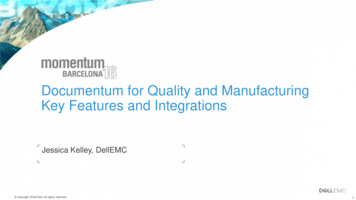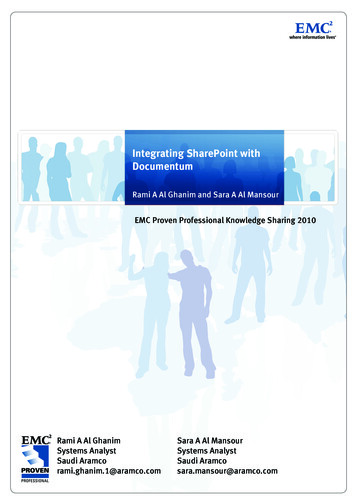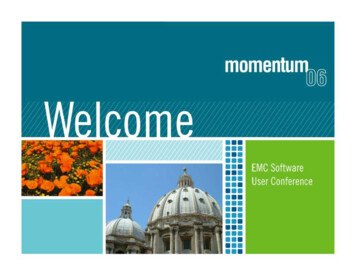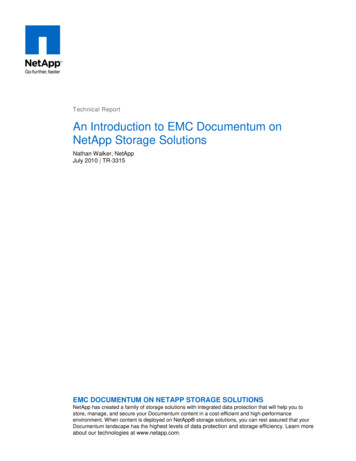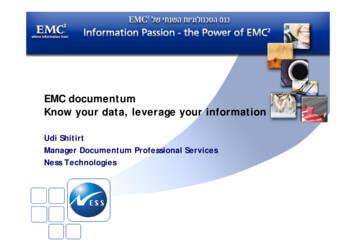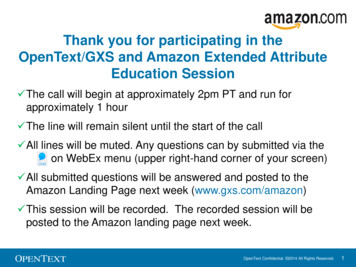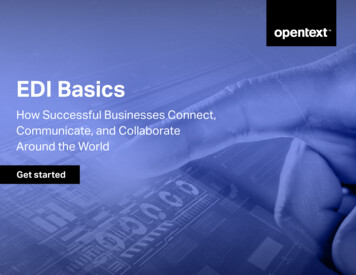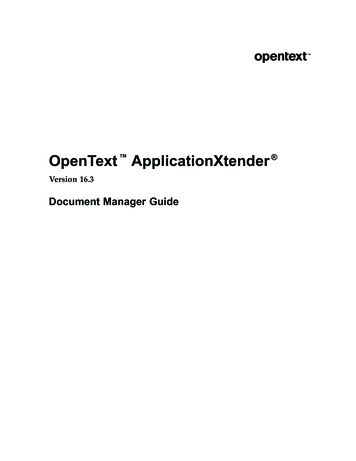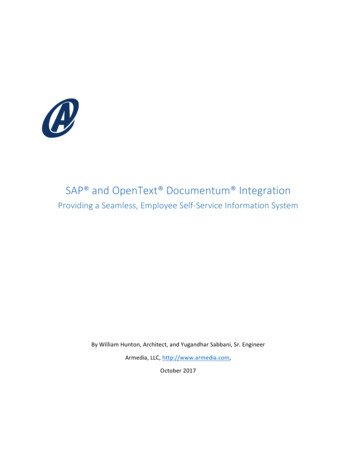
Transcription
SAP and OpenText Documentum IntegrationProviding a Seamless, Employee Self-Service Information SystemBy William Hunton, Architect, and Yugandhar Sabbani, Sr. EngineerArmedia, LLC, http://www.armedia.com,October 2017
SAP – Documentum IntegrationIntroductionSAP has integrated with OpenText and Documentum products for many years. The Documentumproduct capabilities in document management and archiving, version management, recordsmanagement, and robust content security complement many of SAP’s products that need a backendrepository to house unstructured content, as well as to provide downstream business capability.As a systems integration and enterprise content management solutions firm with expertise inDocumentum and SAP, Armedia, LLC, is a natural partner for government and commercial clients lookingto integrate SAP with various ECM products.In this case study, we’ll present the challenges faced by a Fortune 100 company moving from an older,legacy employee information system to SAP HRMS and SuccessFactors , while providing its worldwideemployees a modern, seamless, functionally consistent information system. We will describe howArmedia partnered with our customer and another consulting and integration services firm thatspecializes in SAP to quickly build the desired solution. We will describe the Documentum product stackand system integration architecture.DescriptionRecently, a customer contacted Armedia about a project in which they were already deeply engaged. Ithad hit a roadblock. The project was to build an employee-facing information system using HANAEnterprise Cloud SAP HRMS and Success Factors as the core technology. Our initial analysisdetermined the size and security requirements of the backend SAP ArchiveLink repository.The production deadline was rapidly approaching and a lot of work remained. Armedia quicklypartnered with our customer and jointly determined additional requirements as well as performanceimprovements. The requirements are described below.Process FlowThe integrated SAP/Documentum system to be designed included an additional enhanced workflow toallow employees themselves or authorized personnel to update employee information through a userinterface connected to SAP:ARMEDIA, LLC2
SAP – Documentum IntegrationUser submits form The user submits achange to personnelrecords by way of aformSAP integrates withDocumentumDocumentum managesthe content The form isprocessed by SAP.SAP connects toDocumentumArchive Services forSAP (ASSAP) andsubmits the form toDocumentum The form is storedin a Documentumrepositorydesignated as theSAP ArchiveRepositoryThe customer’s human resources (HR) manager and other HR employees with the proper authority canaccess the employee data and content directly in Documentum. The customer’s Records Manager canalso view such records but with more restricted access, so that the actual employee content is notaccessible, and it is also encrypted within the storage system.When an employee’s first form is ingested, if there is no employee record in Documentum, then one iscreated. Subsequent forms are linked to the employee. Ingestion of the form activates a web servicewhich pulls employee data from the legacy system. The application stores it in the new employeerecord in Documentum. If the employee record already exists in Documentum, changes to theemployee data may not be required, but the form is ingested and linked to the existing employee.Documentum manages the “system of record,” records management, retention policies, and contentencryption.FeaturesOnce the requirements and level of effort for the integrated solution were determined, Armedia’sassignment was to build the SAP Archive Link repository for all the SAP employee transactiondocuments. Here are the business-critical features: Full, seamless integration with SAP to ingest transaction content and employee metadata. Inthis case, the content records consisted of employee information placed into forms, and thearchived format is Adobe PDF.Provide for encrypted content within Documentum.Provide the capability to store and manage encrypted employee forms.Provide the capability to link forms to an employee or groups of employees.Provide tiered security including stricter security to access senior executive content.Provide records management and retention policies for different types of employee forms.Provide the capability to place legal holds on employee records and data via the recordsmanagement functions.Synchronize employee data in Documentum with employee data in the legacy HR system:o Accept mass changes affecting all employees which are not associated with a formstransaction.ARMEDIA, LLC3
SAP – Documentum IntegrationoAccept Individual employee data changes not associated with a forms transaction.SolutionConceptualA conceptual diagram of the solution is shown below. Note that the application can be accessedremotely by authorized users.ARCHIVEContent ServerSAPCabinetTrusted ContentServicesSAPRecordFormRecords ManagerEmployeeDataRetention PolicyServicesEmployeeCabinetWeb ServiceWeb ServiceRemoteUIDocumentumArchive Services for SAPFormContentEmployee DataRecords Managerand HRInternetCorporate NetworkDiagram Description All Documentum components are installed in the customer network behind the firewall. Archive Services for SAP (ASSAP) is a separate licensed product from Documentum. It handlestransaction transmissions from SAP and fetches documents requested by SAP. It processesmany types of SAP document types, including PDF, SAP REO format data tables, and SAP printlists. Trusted Content Services, Records Manager, and Retention Policy Services extend the ContentServer and require a license for the functionality to be activated. Trusted Content Services (TCS) provide encryption on the file system as well as securetransmission between servers and clients. In the diagram, TCS encryption acts upon the“archive.” Records Manager and Retention Policy Services also extend the Content Server. Records Manager exposes logic that allows file plans to be associated with the content. Anemployee may have many types of content files and they may have different retentionrequirements. Retention Policy Services automate the life cycle states and disposition of the employee records. The Web services container represents several services including daily batch processing of sometypes of employee data transactions. Employee data can be accessed by a certified records manager to apply retention policies. Theclient is the Records Manager client. Human Resources can access employee forms content and employee data via the SAPGUI clienthosted by HANA Enterprise Cloud .ARMEDIA, LLC4
SAP – Documentum IntegrationThe Documentum StackHere is the Documentum product stack for this application. It provides “out of box” integration withSAP: Documentum Platform (Content Server)Archive Services for SAP (ASSAP)Trusted Content ServicesRetention Policy ServicesRecords ManagerWebtopDocumentum AdministratorArmedia has architected and implemented various types of Documentum based solutions since 2002.This experience along with our SAP experience enabled us to quickly determine the required products,infrastructure and support needed.ASSAP is one of several SAP integration products by Documentum. It provides a service to store a SAPartifact such as a PDF, a SAP print list, a dataset (REO), and other SAP “documents” in a Documentumarchive.Custom SolutionASSAP provides a way to use Documentum as the archive (the SAP ArchiveLink) for employee forms. Itdoes not provide a way to link the forms to an employee with data in a legacy employee data system.Armedia designed and built a function to support this use case .When an employee submits a form to update data, the transaction triggers the web service, which runsin the background, to access legacy employee data and send it to Documentum. This functionalitysupports Records Management, Retention Policies, and searching employee data and forms.Additional RequirementsArmedia discovered new requirements during the original implementation phase, and we were able toinclude them without affecting the total project budget. They include the following:Employee Record HoldsIn the case of an actionable incident that requires them to be secured for legal purposes, such as atax audit, the custom application places a hold on the employee record or records if more than oneis affected. This prevents access and modification except by authorized customer representatives.We leveraged a previously developed Armedia tool that can lock one to many types of records and itprevent modifications and deletions.Mass UpdateThe new system was to operate day-forward; that is, there no requirement to migrate the legacydata prior to putting the new system in production. Employee data would be migrated as needed.Legacy data would still be accessed in the old system. The migration strategy evolved to create theDocumentum employee data as of the date of a form transmission, and legacy data would then bemigrated to the new system as needed.ARMEDIA, LLC5
SAP – Documentum IntegrationWe also found a need to migrate data in the case of updates not associated with a form transaction.If only employee metadata was changed and there was no form associated with it, then a servicerunning on the legacy system side would fetch the data and pass it to Documentum to updateexisting employee data. It could handle a single employee or multiple employees at one time.Changes are collected daily and run in batch at night.Performance ImprovementsTo improve performance, banner content is managed by SAP. If the banner content were stored inDocumentum, the process load would be too high for the Documentum infrastructure, which wassized for fewer transactions. The banner content structure provides fast response and could betransitioned into the solution without a major impact to the customer’s employee community. Thedeployment was phased in among small groups in HR resulting in a smooth transition.Integration TechnologyASSAP cannot pass attributes associated with an employee to Documentum, such as employee numberor employment date, but this employee data is needed to support records management and enforceretention policies within Documentum. In our integration solution, a forms transaction triggers a webservice, designed by Armedia, to grab the employee data or modify existing data whenever a form wastransmitted to Documentum. The custom process makes the link between the form just processed andthe employee it relates to, all within Documentum.For mass changes affecting large numbers of employees, another web service sends those changes toDocumentum and the employee data is updated. For individual changes, there is a process that runsdaily to take individual changes and applies them within Documentum to the employee record.The SAP record transaction ID is computed in SAP. The SAP record cannot be read, and its format is notvisible. There is no discernable link to a specific employee; the custom web service creates thatassociation inside Documentum. The record content is encrypted, and its location path is a computedvalue making unauthorized access or access outside of Documentum and SAP impossible.SecurityEmployees located worldwide can access their information via SAP, but they do not have direct accessinside Documentum. There are security restrictions which prevent unauthorized access to executiveemployee data.There are several layers and types of security: Executive level employees require higher level permissions to view their records.Restrictive security settings prevent unauthorized browsing, fetching, and reading.Forms content is encrypted in the Documentum repository by Trusted Content Services.Content is securely transmitted using features in Trusted Content Services.Documentum follows all major data security standards. Examples include:o FIPS 140-2 content encryption complianceo PCI, PII DSS complianceo DoD 5015Documentum data security includes Access Control Lists, object level permissions, defaultsecurity settings for the entire repository, Operating System security, exclusion and inclusion ofARMEDIA, LLC6
SAP – Documentum Integrationspecific employees in specific authorized groups, denial of access to computer engineers andDocumentum administrators.Technical ChallengesThe SAP UI and source is provided by a Cloud service transferring data to a secure network application.HANA Enterprise Cloud offers SAP as a service. Legacy data is located in another HR data system. Thecustomer’s data and content had to be secure inside their network and all connections had to meet thestrict security policy. Some issues had to be addressed including policy configurations, IP addresses andports.ConclusionDespite the schedule risks, the client chose Documentum because it provides a backend, SAP ArchiveLink with robust features out of the box. This, combined with custom functionality, provides thefollowing benefits to Armedia’s customer: Secure 24x7 employee and retiree access to the customer’s HR system from anywhere in theworld.A view to SAP Human Resources and Success Factors hosted in HANA Enterprise Cloud.Seamless integration with legacy employee data system outside of SAP.Documentum records management and retention policies.Documentum’s standards based content and data security features.Legal holds on employee records.About Armedia, LLCArmedia is a technology firm, focusing on information and content management solutions. Armedia hasindustry-acclaimed expertise, services and products in Content Intelligence, Big Data Analytics, CaseManagement, Enterprise Content Management, Open Source and Mobile Technologies. Armedia hasexperience providing these services on various platforms, including: Alfresco, Drupal, EMCDocumentum, IBM FileNet, Microsoft SharePoint and the Apple iPad. Armedia has also won manyindustry and business awards, including: Stevie Website of the Year, InfoWorld 100, multiple Inc 5000,Pacesetter, Atlanta’s Best Places to Work, Atlanta’s Best and Brightest. Armedia’s mission is to provideworld-class solutions to its clients and assist them in achieving tangible returns on their technologyinvestments.Armedia is a GSA Schedule IT-70 holder, and is CMMI Level 3 appraised. Armedia has offices in Atlanta,GA and Vienna, VA.ARMEDIA, LLC7
Documentum follows all major data security standards. Examples include: o FIPS 140-2 content encryption compliance o PCI, PII DSS compliance o DoD 5015 Documentum data security include
